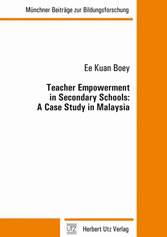Suchen und Finden
Vorwort
6
AKNOWLEDGEMENT
8
ABSTRACT
9
Kurzfassung
10
CONTENT
11
LIST OF TABLES
17
LIST OF FIGURES
18
CHAPTER I INTRODUCTION
20
1.0 Introduction
20
1.1 Teacher Empowerment
20
1.2 Study Context
22
1.3 The Importance of the Topic
22
1.4 Purpose of the Research
24
1.5 Research questions
24
CHAPTER II LITERATURE RESEARCH
25
2.1 The Constructs of Power and Empowerment
26
2.1.1 Empowerment as a Relational Construct
26
2.1.2 Empowerment as a Motivational Construct
27
2.2 Theoretical Framework of Teacher Empowerment
28
2.2.1 Social Structural Empowerment
29
2.2.2 Psychological Empowerment
30
2.2.3 Social Structural and Psychological Perspective Link
31
2.3 Theories of Empowerment
32
2.3.1 Theory X and Theory Y
32
2.3.2 Herzberg’s Two-Factor Theory
36
2.3.3 Self Efficacy Theory
38
2.3.4 Maslow Hierarchy of Needs
41
2.3.5 Integration of Teacher Empowerment and Theories
47
2.4 Teacher Empowerment
47
2.4.1 Decision Making
48
2.4.2 Professional Growth
49
2.4.3 Status
50
2.4.4. Self-Efficacy
50
2.4.5. Autonomy
51
2.4.6 Impact
52
2.5 Job Satisfaction
52
2.6 Teacher Commitment
54
2.7 Research Questions and Central Hypotheses
56
2.7.1 School Reform and Teacher Empowerment
56
2.7.2 Teacher Empowerment and Demographic Variables
62
2.7.3. Teacher Empowerment, Commitment and Satisfaction
64
2.7.4 Teacher Empowerment and Commitment
64
2.7.5 Teacher Empowerment and Satisfaction
69
CHAPTER III METHODOLOGY
76
3.0 Introduction
76
3.1 Research Design
76
3.2 Population and Sample
77
3.3 Description of Respondents
78
3.4 School System in Malaysia
85
3.5 Main Variables
87
3.6 Instrumentation
88
3.7 Data Analysis
89
3.8 Procedures
90
CHAPTER IV RESULTS & DISCUSSION
92
4.0 Introduction
92
4.1 Descriptive Statistics for Teacher Empowerment
92
4.2 Descriptive Statistic of Empowerment Subscales and Demographic Variables
93
4.3 Correlation of Teacher Empowerment Subscales, Commitment and Satisfaction
101
4.3.1 There is a positive Correlation between Empowerment Subscales and Commitment
103
4.3.2 There is a positive Correlation between Empowerment Subscales and Satisfaction
105
4.4 Multiple Regression Analysis of the Empowerment, Commitment and Satisfaction
105
4.4.1 Teacher Empowerment and Commitment Subscales
105
4.4.2 Teacher Empowerment and Satisfaction Subscales
106
4.5 Discussion of the Results
107
4.6 Teacher Empowerment and School Reform 1992
107
4.7 Teacher Empowerment and Demographic Variables
113
4.8 Teacher Empowerment, Commitment and Satisfaction
121
4.9 Summary of the Overall Findings
127
CHAPTER V IMPLEMENTATION & CONCLUSION
130
5.0 Introduction
130
5.1 Implication of the Study
130
5.2 Implementation of Teacher Empowerment in Malaysia (Specific Approach)
134
5.2.1 Intervention I
135
5.2.2 Intervention II
137
5.2.3 Intervention III
143
5.3 Limitations of Study
145
5.4 Future Research
146
5.5 Conclusion
146
References
148
APPENDIX 1 Research Questionnaire for the Study
165
APPENDIX 2 School List and Time Schedule for the Study
171
APPENDIX 3 Multiple Regression Analysis of Teacher Empowerment and Commitment
174
APPENDIX 4 Official Documents for the Study
180
Alle Preise verstehen sich inklusive der gesetzlichen MwSt.




















